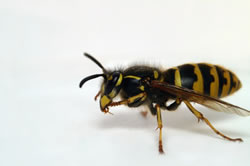How Late in the Year Will Yellowjackets Remain Active?
 |
| Yellowjackets become increasingly aggressive late in the season |
| Photo © Robert Wiacek/iStockphoto |
Yellowjackets are at their pestiest in the late summer or early fall. There are no more developing larvae to feed so workers are foraging randomly for themselves. They can become increasingly aggressive in gathering food and are more likely to sting during this time. Also in the fall, their food interests switch from mainly proteins to mainly sweets. You'll find them buzzing around your soda can, which can mean a nasty surprise if your lips and yellowjacket meet.
In late summer, a yellowjacket colony is at its largest (1,000-4,000 workers), but its social structure is breaking down. The workers have built larger reproductive cells in which new queens have developed. Males are also produced in the late season colony. These reproductives leave the nest and mate and the newly fertilized queens will look for a protected site, such as under loose tree bark, to spend the winter.
Sometimes the overwintering queens will end up seeking shelter inside buildings. In almost all cases, the worker yellowjackets will die at the end of the season, along with the current colony queen.
So, how much longer will yellowjackets be active? It depends on your location. Overall, you can expect peak yellowjacket activity in late summer and early fall in most areas, and the yellowjackets' "pestiferous" activity may extend to late fall, always depending on the weather.
In more northern states, yellowjacket colonies begin to decline in July or August, but some colonies remain active and growing throughout September, which means you can still expect some yellowjacket activity in October. In southern states, reproductives may not even be produced until after September. In rare instances, foraging yellowjackets can be found as late as December, even in northern areas.
In the mountains, yellowjackets have been reported to burrow up through the snow from ground nests to forage for food! Yellowjackets nesting in protected building voids often remain active well into December.
Will Yellowjackets Reoccupy the Same Nest Next Year?
Depending on the species, yellowjackets build a paper-covered nest either in the ground, in trees or shrubs, or in building voids. Old yellowjacket nests are not reused, but sometimes in warmer states like Florida and California there are perennial nests that do not die out over the winter. Perennial nests can contain hundreds of queens and many thousands of workers.
Typically though, a single overwintering queen starts a new nest in a new site in early spring and that nest gradually grows larger throughout the summer.
More Yellowjacket Info...
For more on yellowjacket biology, habits, and identification, click Yellowjacket Biology and Habits.
For advice on finding and treating yellowjacket nests, click How to Find and Treat Yellowjacket Nests.
For advice on protecting public areas from fall yellowjacket problems, click IPM to Control Yellowjackets at Schools, Stadiums, and Public Areas.
